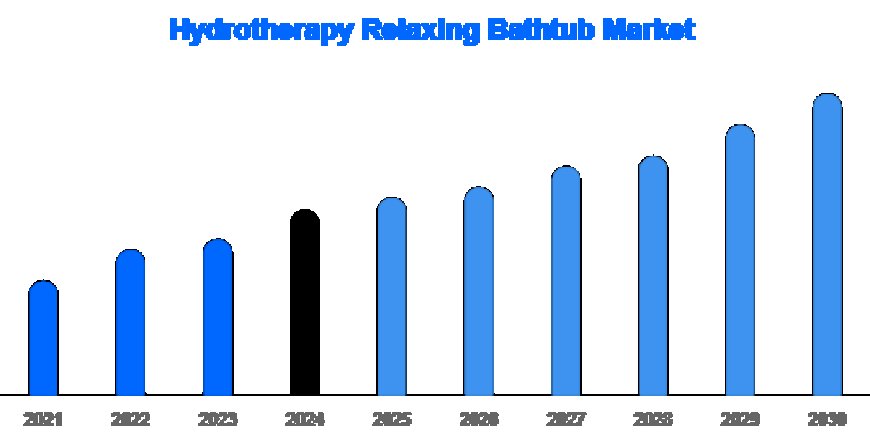Hydrotherapy Relaxing Bathtub Market Overview: Trends, Challenges & Opportunities
The global hydrotherapy relaxing bathtub market size was valued at USD 1.42 billion in 2024 and is estimated to grow from USD 1.55 billion in 2025 to reach USD 2.41 billion by 2030
The globalhydrotherapy relaxing bathtub marketreached an estimatedUSD?1.42?billion in 2024and is projectedUSD?1.55?billion in 2025, with compound annual growth rates (CAGR) of8.7%across various sources. Demand is primarily driven by rising disposable incomes, increased focus on wellness, aging demographics, and innovative technology integration.
Latest Market Trends
- Smart, Connected Baths
Integration of IoT-enabled featuresautomated temperature and jet controls, voice/app-enabled systems, LED chromotherapy, built-in audio/entertainment, and customizable presetsis becoming mainstream. Consumers increasingly desire tubs that can be adjusted remotely and personalized to fit their routines. - Eco?friendly & Energy?efficient Solutions
Brands are responding to growing environmental awareness by introducing recyclable materials, water?saving pumps, high-efficiency heaters, and low-flow jet systems. - Compact & Urban?friendly Designs
As urban dwellers face space constraints, manufacturers are offering narrow-profile, corner, and modular tubs tailored to smaller bathrooms without compromising on hydrotherapy benefits. - Wellness?centric Bathroom Spaces
A holistic wellness trend is reshaping bathroom design. Homeowners now prefer spa-like retreats equipped with saunas, steam showers, aromatherapy features, and integrated hydrotherapy tubs for full sensorial experiences. - Luxury & Lifestyle Integration
Demand in premium residential and hospitality sectors is rising, with tubs being packaged as high-end lifestyle additions rather than mere fixturescomplete with bespoke finishes, designer branding, and integrated entertainment systems.
Market Challenges
- High Upfront and Installation Costs
Advanced hydrotherapy tubs remain expensive. When installation, plumbing modifications, and maintenance are considered, total costs can discourage middle-income buyers. - Water Consumption & Sustainability Concerns
Prolonged fills and frequent use increase water usageposing ethical and regulatory challenges in regions with water scarcity. - Space Limitations in Dense Urban Areas
Even compact tubs present fitting challenges in small bathrooms, amplifying renovation complexity and costs. - Maintenance Complexity
Advanced features (jets, electronics, filters) increase maintenance needs, making upkeep cumbersome for consumers accustomed to simpler tubs.
Opportunities Driving the Market
- Emerging Market Expansion
As income levels rise in Asia?Pacific and Latin America, new demand is being unlocked. Urban building projects increasingly include luxury hydrotherapy options. - Healthcare Partnerships
Collaboration with hospitals, rehabilitation, elder- care, and physiotherapy centers to adopt hydrotherapy tubs in therapeutic and recovery settings is gaining traction. - Modular & Retrofit Solutions
Innovating retro?fit models or space?adaptive units that can be easily installed in existing bathrooms can address urban constraints. - E?commerce & Digital Sales
Online platforms simplify discovery and purchase processes, allowing brands to reach niche buyers with customizable options supported by AR/VR digital previews. - Cross?category Product Bundling
Packages combining tubs with steam showers, smart lighting, aromatherapy modules, or in-home entertainment systems offer cohesive wellness experiences and higher ticket values.
Market Segmentation Overview
|
Segment |
Description |
|
A. By Product Type |
Includes freestanding, built-in, walk-in, combination, soaking, whirlpool, air, and medically assisted tubs. Freestanding and walk-in variants are gaining momentum due to aesthetics and accessibility. |
|
B. By Material |
Covers acrylic, fiberglass, cast iron, stone resin, ceramic, and ceramic composite. Acrylic and stone resin lead due to their lightweight durability and premium tactile appeal. |
|
C. By Features |
Multi-feature tubs include water jets, chromotherapy lighting, heated surfaces, customizable jets, aromatherapy integration, and connectivity features (audio, app control). Offerings with chromo- and audio-therapy are growing fastest. |
Top Players Developments
Major players in this market includeJacuzzi,Kohler,MTI Baths,BTL International,Hydro Massage Products,BEKA Hospitec,Trautwein,Vacu Activ, andSignature Hardware.
Key Developments
- Kohler
AcquiredKlafs(a German sauna and wellness brand) in 2024/25, signaling a major push into holistic home-spa arenas and bolstering bathroom wellness solutions. - Jacuzzi
Expanded its product range with smart bath systems featuring app?controlled water jets and mood lighting; launched wellness bundles combining tubs with steam-shower units. - MTI Baths
Launched eco-series tubs with high?efficiency insulation, low?flow jets, and recycled acrylic materials to meet eco-friendly consumer preferences. - BTL International
Formed partnerships with rehabilitation centers to provide specialized walk-in hydrotherapy tubs optimized for clinical therapy use. - Hydro Massage Products
Introduced compact in-line bath massage units retrofit for existing tubsaimed at renters or small-home owners wanting hydrotherapy without full replacements. - BEKA Hospitec / Trautwein
Strengthened presence in medical-grade bathtubs sector via distribution deals and collaborated with healthcare providers in Europe.
Mergers and Strategic Deals (202425)
- Kohler + Klafs acquisition marks a consolidation of sauna and hydrotherapy under one wellness provider packaged for high-end home builds.
- BTLRehabilitation Partnerships BTLs clinical tubs are being adopted in hospital rehab centers globally.
- Hydro Massage Partnerships Integration agreements with boutique apartment developers in urban hubs across North America and Europe.
Conclusion
The hydrotherapy relaxing bathtub market is entering a new eratransitioning from standalone fixtures toholistic wellness hubs. Growth is powered by smart connectivity, eco-conscious design, modular installations, and health-sector alignment. While challenges around cost, spatial constraints, and water efficiency persist, innovation in compact, energy-saving models and expansion into emerging economies present abundant opportunities. Major brands are evolving into comprehensive wellness providerspositioning tubs as lifestyle-enhancing investments rather than mere appliances.
About Us
Deep Market Insights is a market intelligence company providing global business information reports and services. Our exclusive blend of quantitative forecasting and trends analysis provides forward-looking insight for thousands of decision-makers. Deep Market Insights provides actionable market research data, especially designed and presented for decision making and ROI.
Frequently Asked Questions
- What is the current and forecasted market size?
In 2024, the market stood nearUSD 1.42 billion, expected to grow toUSD 2.41 billion by 2030, with annual growth between 8.7%. - What technologies are defining smart hydrotherapy tubs?
Smart features include voice/app control, chromotherapy lighting, customizable jets, in?bath entertainment, pre?sets, and energy-saving sensors. - Why are walk-in tubs gaining popularity?
Walk-in tubs cater to elderly and physically challenged users, reducing fall risk and improving accessibilityan important niche in both residential and clinical markets. - Which region is projected to grow fastest?
The fastest-growing markets areAsia?PacificandLatin America, propelled by rising incomes, urban wellness trends, and expanding hospitality infrastructure. - What are the sustainability concerns?
Main issues include high water use per session, energy for heating large volumes, and lifecycle impacts of tub materials. Energy- and water-efficient designs are crucial countermeasures.




































